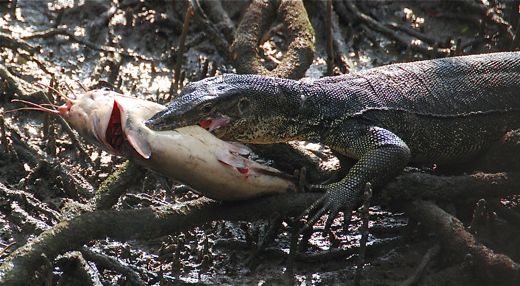Meibao sent in this note and the image above:
“I was lucky enough to see a monitor lizard with a very very fresh-looking catfish in its jaws during low tide. (At the main bridge just outside the main hide.)
“Suspect it just got lucky and managed to get a catfish that got stranded when the tide receded. But it went off with the fish when it realised it had a big group of spectators, so didn’t manage to watch it feed.
“The last time I came across a feeding monitor lizard, the stench of the rotting fish was very obvious. And it “re-aligned” the fish and swallowed it in one gulp.”
The population of the Malayan Water Monitor (Varanus salvator) in the Sungei Buloh Wetland Reserve has increased so much that you see them everywhere. But seeing one with a large catfish in its jaws must be an exciting occasion. More exciting than seeing birds, I presume.
Obviously, there are more than birds at the reserve…. Crocs, Smooth Otter and more.










4 Responses
you should see this monster in my toilet bowl… arghh still searching an information on how to catch this monitor lizard…
To catch a monitor lizard, you need about 3 meters of very strong monofilament fishing line (at least 50 kg breaking strain) some sticky tape, a long, thin stick or bamboo, and a large, thick towel. Industrial gloves are optional. They can be purchased from hardware shops at about $5 per pair.
Make a noose with the line. Attach the noose lightly to the stick with the tape. Grip the other end of the line securely. Very slowly and gently manoeuvre the noose over the head of the lizard. Jerk it tight in the direction of the tail.
Watch all hell break loose.
The stick will probably be of no further use. Haul the lizard by the line to an open area. Throw the towel over its head, making sure that its eyes are well and truly covered. Make a simultaneous grab for the neck just behind the head, and the hips, at the junction of the hind legs and tail.
It is important that you secure both ends and straighten the lizard out. If you grab just the head, the lizard will double over and inflict scratches with its claws. If you get just the rear, the lizard will turn around to bite.
Do not become a party to an ongoing scientific controversy. It has been argued that at least one species of monitor lizard (the Komodo dragon) is venomous. The question is still unresolved about the other species found in Singapore. Want to spend $5 on gloves?
Despite their fearsome armament, water monitors are actually rather docile and make good neighbours, provided that you make sure that they cannot enter aviaries and chicken coops. When Yishun was still a rural area, one about 1.5 meters long used to come to be fed outside the outdoor bathroom of my family’s factory. Even today, another one, about 1 meter long, shows up for meals daily in the spacious garden of my friend who lives in Sembawang.
If you are prejudiced against a monitor lizard in your neighbourhood, take it for a long ride to a wet and overgrown area. I might also add that monitor lizards are edible and prized in Chinese cuisine.
Good article! We will be linking to this
great article on our website. Keep up the great writing.